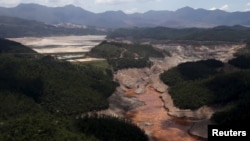As despair turns to anger over a deadly dam burst at a Brazilian mine, lawmakers pushed on Tuesday for tougher regulations in a new mining code and iron ore giant Vale SA came under pressure to help mourning families and contain the environmental impact.
In five days of rescue efforts in towns ravaged by the massive mudflow, six bodies have been found and 22 people are still missing, making it one of the worst mining disasters in Brazil's history.
The tragedy in the southeastern state of Minas Gerais has displaced hundreds of residents, triggered investigations by prosecutors and spurred calls for stricter oversight of the mining industry, a huge provider of jobs and government tax receipts in the mineral-rich state.
The chief sponsor of a new mining code in Congress, Leonardo Quintão, told Reuters on Tuesday that he planned to add measures to tighten regulation of tailings dams like the two that collapsed on Thursday, which hold back waste water from processing iron ore.
Minas Gerais Governor Fernando Pimentel acknowledged state mining regulations are not enough to effectively supervise such operations and his aides said they may need to rethink their efforts to fast-track licensing.
The insurance industry is also coming to grips with the disaster, which could trigger up to $600 million in claims, according to a source with direct knowledge of the matter.
Yet the nearly 600 residents who fled Bento Rodrigues, a poor village in the shadow of the dams that was nearly erased by mudslides, worry they will never return home.
"Nobody wanted to leave there. It was such a nice life. And now it's been taken away from us. It's theirs now," said Eliana Santos, 32, referring to the mine operator Samarco, where she worked as a contractor.
Public criticism fell first on Samarco but the spotlight has quickly turned to the big names behind the 50-50 joint venture: Australia-based BHP Billiton Ltd., the world's largest mining company, and Brazilian partner Vale , the biggest iron ore miner.
"Samarco is just a name they made up. We need BHP and Vale to take responsibility for this tragedy," said Duarte Junior, mayor of the town of Mariana, who has coordinated relief efforts.
Sharp Contrast
BHP's public response has been rapid. Vale, one of Brazil's biggest companies and its No.1 exporter in recent years, appeared aloof in the four days after the dams burst. Facing mounting criticism, it issued a lengthy statement on Tuesday enumerating the steps it had taken since the dams collapsed.
BHP Chief Executive Andrew Mackenzie held a news conference in the hours following the disaster and the company announced he would travel to Brazil to survey the damage. It has also splashed almost daily updates on the tragedy in English and Portuguese across the top of its website.
By contrast, until Tuesday, Vale had only released a five-sentence statement some 24 hours after the dams collapsed and referred early questions to Samarco. Vale CEO Murilo Ferreira made an unannounced visit to Mariana on Saturday, which the company revealed two days later.
Mariana's mayor has worked closely with Samarco, but he said that no senior executives from Vale or BHP Billiton had contacted him.
Influential columnist Miriam Leitao excoriated Vale on Tuesday for its "absolutely insufficient" response.
"Vale has been drilling and dumping around Minas Gerais for 70 years," Leitao wrote in newspaper O Globo. "After a disaster of this scale, it can't issue a laconic statement as if it weren't obliged to act immediately."
She called on Ferreira to explain how Vale will compensate displaced families, contain the environmental damage and monitor the ongoing effects of the spill downstream.
In response the company released a statement - just its second since the disaster - headlined "Vale has supported Samarco since the first day of the accident."
About 100 employees have been involved in search and rescue efforts, including medical staff, social workers, outdoor experts, two geotechnical engineers and a dam specialist, Vale said.
The company said it had also provided helicopters and 30,000 liters of fuel, as well as three cars, two ambulances, five off-road trucks, a bulldozer and a new well for a nearby village.
"We will do everything we can to help rebuild the lives of the affected people, and to restore the environment," Ferreira said in the statement.
The length and detail of Vale's news release underscored the rising scrutiny of its public response. A company representative also said Ferreira would join Mackenzie in Mariana on Wednesday.
The federal government has drawn criticism too, for leaving state authorities to sort out the environmental impact of the collapsed dams and 60 million cubic meters of wastewater contaminating rivers and coastline over 500 km (300 miles) away.
Biologists warn that the environmental impact may be permanent, devastating local fisheries and farms. Wood pulp maker Cenibra suspended operations at two production lines due to the mudflow threatening its water source.
President Dilma Rousseff has not traveled to the disaster area, although she said in at a speech on Tuesday that she is "very worried" about the mud and waste from the burst dams making its way downstream. She said her government was ready to help state and local authorities.








